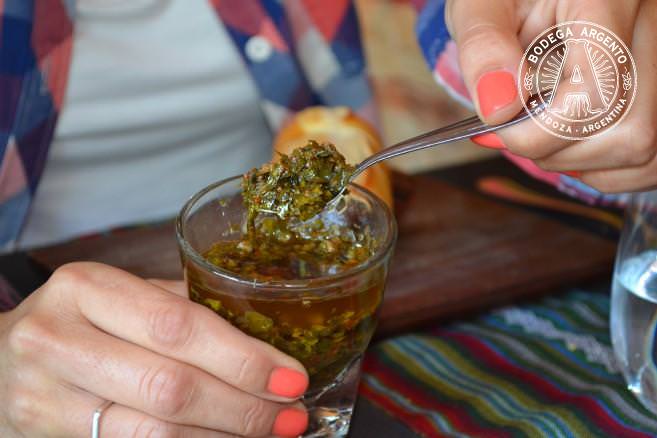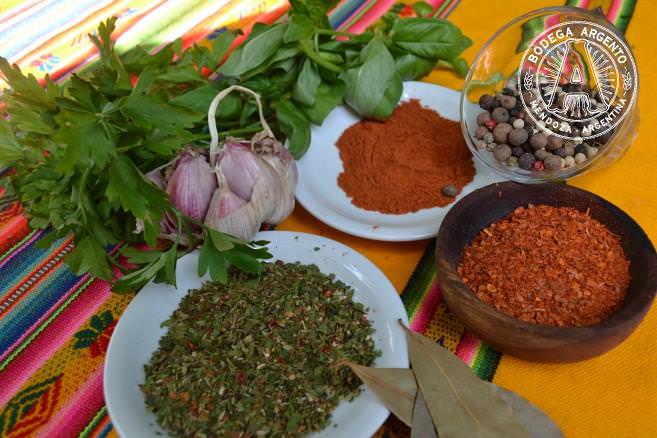Chimichurri. Savor the word, roll those R’s. This is a sauce to be taken seriously. Surely the most popular condiment in the country, chimichurri is a succulent parsley, oregano, garlic and chili concoction beloved of all Argentines. It can be bright green or a murky brown, but the best chimichurri is chock full of chunky, herby goodness and bursting with flavor. You’ll want to get the grill going because chimichurri is perfect with an asado. Here’s how to get a tangy, garlicky flavor of Argentina in a sauce that’s so simple to make, and surprisingly versatile, you’ll wonder how you lived without it.

History of Chimichurri
This most famous Argentine sauce was probably first mixed together by gauchos – cowboys – who used it to flavor the meat they prepared over open fires when on the pampas.
Depending on who you believe, the name chimichurri comes from the Basque country word tximitxurri, meaning “a mixture of several things in no particular order”, or from a modification of “Jimmy’s curry”. In this case, the eponymous Jimmy was apparently a 19th Century Irishman or Englishman who was either a meat trader or a freedom fighter, according to various myths. Because his name was difficult for Argentines to pronounce, “Jimmy’s curry” got turned into chimichurri.
Today many households always have a bowl of chimichurri on the table to accompany whatever meat or pasta dishes are being served that day.
Chimichurri essentials
Chimichurri, like many condiments with a long history, has many variations but the purists stick to a preferred blend of chopped parsley, chopped garlic, oregano, red chili pepper flakes, and olive oil with a hint of vinegar.

You simply cannot miss out the parsley or the garlic. Flat leaf parsley imparts the best flavor, and the garlic cloves should be plump and succulent. When it comes to oregano, it is actually more traditional to use dried oregano. But if you have access to a fresh supply it doesn’t hurt to include it.
Experiment with the quantities as you may prefer a more garlicky sauce, or a more bitter taste with an increase in chili heat.
ARGENTO COOK prepared a recipe for argentine Chimichurri with a secret ingredient, watch it:
Chimichurri ingredients:
2 bunches of fresh parsley
1/2 bunch of fresh basil
2 chopped garlic
3 tbsp of dried oregano
1 1/2 tbsp of crushed red chili flakes
1 tsp Smoked paprika
1/2 glass Red wine vinegar
1 glass Extra virgin olive oil
2 Bay leaves
Salt and ground pepper to taste
Roughly chop all the ingredients and combine in a bowl. You can chop it all by hand for a chunky final result or pulse it in a blender. Let it sit for a while in the fridge, and then serve. You can keep any leftovers in a jar in the fridge for a few days.
How to Eat Chimichurri
Let’s get one thing straight – chimichurri is not the “ketchup of Argentina”. This moniker is somewhat insulting to Argentines who see chimichurri as less of a fast food staple and more of a gourmet pleasure. Ketchup is widely available in Argentina for burgers and fries, but not many people choose chimichurri to flavor these meals. And as far as I know, chimichurri is not available in sachets in McDonalds.
The most common way to serve chimichurri in Argentina is in a big metal or wooden bowl with asado – a condiment for the grilled meats and offal that make up the traditional Argentine barbeque. Or, chimichurri is often provided with the chorizo sausages (Choripan) or empanadas that form the first course of the barbeque feast. It is sometimes used as a marinade.
But while asado purists may say that chimichurri is just for grilled meat, it is so versatile you’ll find a host of other uses. While it perfectly matches the richness of beef, it is also a good sauce for grilled chicken or even fish. Try chimichurri slavered on thick, crusty bread. Or toss fresh boiled potatoes in chimichurri for a piquant side dish (great with meat, of course.) Chimichurri is excellent with roast vegetables, too.
Chimichurri with Coriander?
As interest in Argentina’s cuisine continues to grow, many variations on traditional chimichurri are appearing across the globe. Some recipes call for the addition of a sprig or two of thyme. Some people make chimichurri with coriander, or even kale. Others add fresh chopped tomatoes to the mix.
But can you still call the famous sauce chimichurri when it’s made with kale? That’s a different matter.


Latest posts by Louise Carr de Olmedo (see all)
- 12 FRESH ORGANIC OPTIONS IN BUENOS AIRES - December 15, 2016
- WHERE TO EAT VEGAN FOOD IN BUENOS AIRES - December 15, 2016
- WHERE TO GO GLUTEN FREE IN BUENOS AIRES - December 15, 2016


 Looking Back with Bocas Abiertas: Buenos Aires Food and Wine Festival
Looking Back with Bocas Abiertas: Buenos Aires Food and Wine Festival  Clo Clo restaurant. A classy timeless tradition in Buenos Aires
Clo Clo restaurant. A classy timeless tradition in Buenos Aires  WHAT’S THE BEEF? OUR INSIDER’S GUIDE ON THE BEST CUTS TO ORDER AND WHERE IN BUENOS AIRES
WHAT’S THE BEEF? OUR INSIDER’S GUIDE ON THE BEST CUTS TO ORDER AND WHERE IN BUENOS AIRES  We Love… Choripan, the Ultimate in Argentine Street Food
We Love… Choripan, the Ultimate in Argentine Street Food  Celebrating Easter in Argentina
Celebrating Easter in Argentina  Argentine National Dishes: Parrilla
Argentine National Dishes: Parrilla  Offal! An introduction to the best parts of an Argentinean Asado
Offal! An introduction to the best parts of an Argentinean Asado  BURGERS AND WINE: THE 2016 PAIRING
BURGERS AND WINE: THE 2016 PAIRING  Yes, you can! Enjoy seafood in Buenos Aires
Yes, you can! Enjoy seafood in Buenos Aires  Discover the best argentinean restaurant in London
Discover the best argentinean restaurant in London  A Meat-Lover’s Guide to Beef Cuts in Argentina
A Meat-Lover’s Guide to Beef Cuts in Argentina  Discover the Art of Butchery in Argentina
Discover the Art of Butchery in Argentina